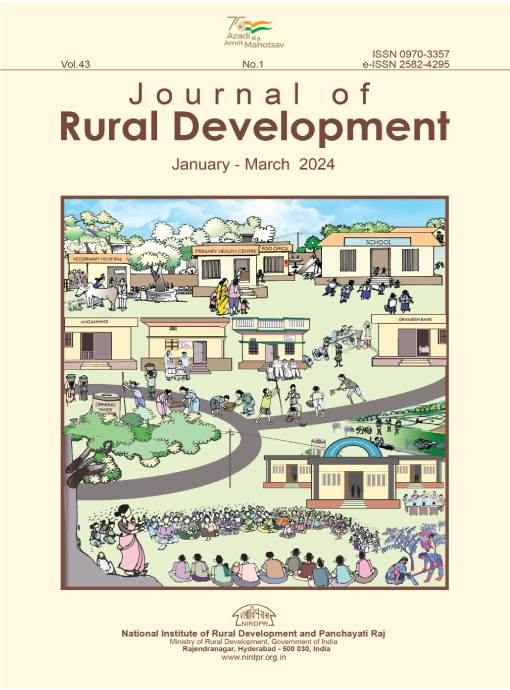Ayurveda Healthcare Utilisation Pattern, Preferences and Determinants in India: An Institutional Case Study
DOI:
https://doi.org/10.25175/jrd/2023/v43/i1/173248Keywords:
Healthcare Access, NCDs, T&CM, Arya Vaidya Sala Kottakkal Hospital, India.Abstract
This paper examines over 5,03,220 institutional outpatient and 42,492 inpatient cases, and 1492 patient surveys to analyse the adoption trends and utilisation patterns of Ayurveda healthcare. The analyses reveal significant adoption of Ayurveda for various non-communicable diseases (NCDs) related explicitly to neuromuscular and neurodegenerative diseases, musculoskeletal disorders and inflammatory arthritis, among other diseases across different age groups with some gender differences in their adoption. Given that the global burden of these diseases is very high, the findings underscore the importance of Ayurveda in treating NCDs and advocating for inclusive healthcare policies and increased research for empowering patients to make informed choices that contribute to universal healthcare access.
Downloads
Downloads
Published
How to Cite
Issue
Section
References
Banerjee, S. (2021). Determinants of Rural-Urban Differential in Healthcare Utilization among the Elderly Population in India. BMC Public Health, 21, 939. https://doi.org/10.1186/s12889-021-10773-1 DOI: https://doi.org/10.1186/s12889-021-10773-1
Baru, Rama., Acharya, A., Acharya, S., Shivakumar, A., & Nagaraj, K. (2010, September), Inequities in Access to Health Services in India: Caste, Class and Region. Economic and Political Weekly, 45 (38), 49–58.
Beshears, John., Choi, J J., Laibson, D, Madrian, B. C (2008), How are Preferences Revealed? Journal of Public Economics, 92 (8-9), 1787-1794. DOI: https://doi.org/10.1016/j.jpubeco.2008.04.010
Chaturvedi, S., Porter, J., Gopalakrishna Pillai, G. K., Abraham, L., Shankar, D., & Patwardhan, B. (2023). India and Its Pluralistic Health System—A New Philosophy for Universal Health Coverage. The Lancet Regional Health. Southeast Asia, 10, 100136. https://doi.org/10.1016/j.lansea.2022.100136 DOI: https://doi.org/10.1016/j.lansea.2022.100136
Chowdhury, S. and Kundu, P. (2018). Alternate Systems of Medicine in India—How Pervasive and Why? Journal of Health Management, 20 (2), 178-189 DOI: https://doi.org/10.1177/0972063418763653
GoI. (2019). Key Indicators of Social Consumption in India: Health, NSS 75th Round, July 2017-June 2018. New Delhi: Ministry of Statistics and Programme Implementation, National Statistical Office.
Grams, Nathalie. (2019). Homeopathy—Where is the Science? A Current Inventory on a Pre-Scientific Artifact, EMBO Reports, 20 (3). DOI: https://doi.org/10.15252/embr.201947761
Haenssgen, Marco. J., and Ariana, Proochista. (2017). Healthcare Access: A Sequence-Sensitive Approach. SSM - Population Health, 3, 37–47. DOI: https://doi.org/10.1016/j.ssmph.2016.11.008
Jana, Arnab and Basu Rounaq. (2017). Examining the Changing Health Care Seeking Behaviour in the Era of Health Sector Reforms in India: Evidence from the National Sample Surveys 2004 & 2014. Glob Heal Res Policy, 2 (1), 1–9. DOI: https://doi.org/10.1186/s41256-017-0026-y
Jeermison, R. K. (2020). Review Article (AYUSH) on the Significance of Traditional Medicine in India. Journal of Research In Traditional Medicine, 6 (1), 29-36. DOI: https://doi.org/10.5455/jrtm.2020/87185
Kasl, S. V., and Cobb, S. (1966). Health Behavior, Illness Behavior, and Sick-Role Behavior. Archives of Environmental Health, An International Journal, 12 (4), Retrieved from https://doi.org/10.1080/00039896.1966.10664421. DOI: https://doi.org/10.1080/00039896.1966.10664421
Kroeger, A. (1983). Anthropological and Socio-Medical Health Care Research in Developing Countries. Social Science and Medicine, 17 (3), 147-161. DOI: https://doi.org/10.1016/0277-9536(83)90248-4
Kundu, J., Bharadwaz, M. P., Kundu, S., and Bansod, D. W. (2022). The Interregional Disparity in the Choice of Health Care Utilisation among Elderly in India. Clinical Epidemiology and Global Health, 13 (4), 1-7, doi:https://doi.org/10.1016/j.cegh.2021.100929. DOI: https://doi.org/10.1016/j.cegh.2021.100929
Lakshmanasamy, T. (2021). Demand for AYUSH Healthcare in India: Multinomial Logit Estimation of the Utilisation of Indian System of Medicine. Journal of AYUSH: Ayurveda, Yoga, Unani, Siddha and Homeopathy, 10 (2), 18-26,
Mahapatro, S. R., James, K. S., & Mishra, U. S. (2021). Intersection of Class, Caste, Gender and Unmet Healthcare Needs in India: Implications for Health Policy. Health Policy OPEN, 2, 100040. https://doi.org/10.1016/j.hpopen.2021.100040 DOI: https://doi.org/10.1016/j.hpopen.2021.100040
Malhotra, C., and Do, Y. K. (2013). Socio-economic Disparities in Health System Responsiveness in India. Health Policy Plan, 28 (2), 197-205. DOI: https://doi.org/10.1093/heapol/czs051
Mohanty, P. C., & Sharma, K. (2021). Households’ Responses on Medical Pluralism: Dynamics and Determinants of Access to Traditional Medicines in India, Clinical Epidemiology and Global Health, 12, 1-8. DOI: https://doi.org/10.1016/j.cegh.2021.100880
National Health Mission. (2010). “Mainstreaming Ayush Under NRHM,” http://www.nrhmorissa.gov.in/frmMainstreamingAyushUnderNRHM.aspx.
NSSO. (2012). “India - Household Consumer Expenditure,” NSS 68th Round Sch1.0 July 2011 - June 2012, Ministry of Statistics, Government of India.
NSSO (2018). “India - Household Social Consumption: Health,” NSS 75th Round Schedule-25.0, July 2017-June 2018.
Patel Gupteswar, Caragh Brosnan & Ann Taylor. (2023). Understanding the Role of Context in Health Policy Implementation: A Qualitative Study of Factors Influencing Traditional Medicine Integration in the Indian Public Healthcare System. Health Sociology Review, 32(3), 294–310. https://doi.org/10.1080/14461242.2023.2210550 DOI: https://doi.org/10.1080/14461242.2023.2210550
Patel, G., Brosnan, C., Taylor, A., & Garimella, S. (2021). The Dynamics of TCAM Integration in the Indian Public Health System: Medical Dominance, Countervailing Power and Co-optation. Social Science & Medicine (1982), 286, 114152. https://doi.org/10.1016/j.socscimed.2021.114152 DOI: https://doi.org/10.1016/j.socscimed.2021.114152
Rudra, S., Kalra, A., Kumar, A., & Joe, W. (2017). Utilization of Alternative Systems of Medicine as Health Care Services in India: Evidence on AYUSH Care from NSS 2014. PloS one, 12(5), e0176916. https://doi.org/10.1371/journal.pone.0176916 DOI: https://doi.org/10.1371/journal.pone.0176916
Singh, R. H. (2015). Declining Popularity of AYUSH, the Recent Report of National Sample Survey Organization. Annals of Ayurvedic Medicine, 4 (1-2), 2-4.
Srinivasan, R., and Sugumar, V. (2017). Spread of Traditional Medicines in India: Results of National Sample Survey Organization’s Perception Survey on Use of AYUSH. Journal of Evidence-Based Complementary & Alternative Medicine, 22 (2), 194-204. DOI: https://doi.org/10.1177/2156587215607673
UN (2015): “Transforming Our World: the 2030 Agenda for Sustainable Development,” 21 October 2015, A/RES/70/1.
WHO (2001): “Legal status of Traditional Medicine and Complementary/Alternative medicine: A Worldwide Review,” Geneva: World Health Organization.
WHO (2019): “WHO Global Report on Traditional and Complementary Medicine,” Geneva: World Health Organisation.
WHO (2023) World Health Statistics 2023: Monitoring Health for the SDGs. Sustainable Development Goals, Geneva: World Health Organisation.






